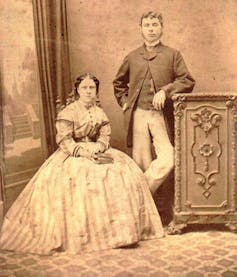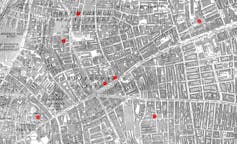THE EAST END OF LONDON IN 1888
SLUM LAND LONDON?
The East End of London in 1888 is often depicted as being one vast slum that was inhabited by an immoral and criminal population who were little better than savages.
Whereas this was most certainly true of certain sections, it is, perhaps, a little unfair to tarnish the entire district with the reputation of being a hotbed of vice, villainy, drunkenness and debauchery.
It should be remembered that many of the writers and journalists who portrayed it in this way had vested interests in so depicting it, be it to attract attention to the area's more unsavoury aspects and locations in order to bring about social change, or simply because there was little newspaper-selling shock value in calling attention to the law abiding, hard working citizenry that also lived in the East End of London, and which may well have made up the majority of the local population.
LONDON'S MANY GHETTOES
Of course parts of the East End were, without doubt, lawless ghettoes where the people lived in appalling conditions.
But this was also the case with the rest of London. Chelsea, Westminster, Lambeth, Marylebone and even the City of London, all had their enclaves that were as bad as, if not worse than, the East End slums.
THE RIPPER MURDERS FOCUSED ATTENTION

However, largely as a result of the huge amount of press coverage afforded the Jack the Ripper murders - which did take place in one of the East End's most densely populated, crime-ridden and vice infested quarters - it is the reputation and appearance of the small section where the murders occurred that has, to an extent, become the most enduring image of the East End as a whole.
AN UNDESERVED IMAGE
But it is an image that was greatly undeserved by much of the East End in 1888 and, more importantly, was largely undeserved by the district of Whitechapel - the name of which is now synonymous the world over with the Jack the Ripper crimes.
Yes, Whitechapel had its slums, its no go areas and its criminal populace. But it also had some very respectable areas and the large percentage of those who lived there were extremely hard working and exceptionally law abiding.
CANON BARNET'S OPINION
Indeed on the 19th September 1888, at the height of the Jack the Ripper scare, Canon Samuel Barnet, the vicar of St Jude's church on Commercial Street - who was an ardent campaigner for social change in the area and who was, therefore, familiar with the slum areas - wrote to The Times newspaper and pointed out that "... The greater part of Whitechapel is as orderly as any part of London, and the life of most of its inhabitants is more moral than that of many whose vices are hidden by greater wealth..."
But, of course, these were not the type of people that the social reformers and philanthropists could utilise in their battle to bring about change. Nor were they the type of people that journalists could shock their readers with in order to increase newspaper sales. Their sensation seeking readers thirsted after salacious accounts of crimes and criminals, or rogues and unfortunates, drunken brawls and dark deeds of infamy.
Thus the honest, hard working East Enders found themselves largely ignored, and it was the areas, admittedly large, underclass that became the stereotypical East Ender in the eyes of many.
As one commentator has put it:-
"A shabby man from Paddington, St. Marylebone or Battersea might pass muster as one of the respectable poor. But the same man coming from Bethnal Green, Shadwell or Wapping was an “East Ender”; the box of Keating’s bug powder must be reached for, and the spoons locked up… it became a concentrated reminder to the public conscience that nothing to be found in the East End should be tolerated in a Christian country."
http://www.jack-the-ripper.org/east-end.htm However, largely as a result of the huge amount of press coverage afforded the Jack the Ripper murders - which did take place in one of the East End's most densely populated, crime-ridden and vice infested quarters - it is the reputation and appearance of the small section where the murders occurred that has, to an extent, become the most enduring image of the East End as a whole.
However, largely as a result of the huge amount of press coverage afforded the Jack the Ripper murders - which did take place in one of the East End's most densely populated, crime-ridden and vice infested quarters - it is the reputation and appearance of the small section where the murders occurred that has, to an extent, become the most enduring image of the East End as a whole.






















